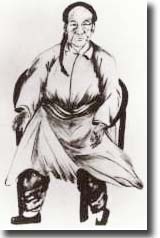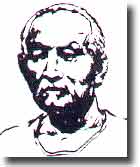
| Home | |||
| Overview | |||
| Shaolin | |||
| Hsing Yi | |||
| Tai Chi | |||
| Bagua | |||
| History | |||
| Gen 2A | |||
| Gen 2C | |||
| Gen 3 | |||
| Family tree | |||
| Philosophy | |||
| Practice | |||
| References | |||
| Baji | |||
| Health | |||
| Other Styles | |||
|
|
|||
| Links | |||
| Directory | |||
| News | |||
ong Hai Chang (Tung Hai-Chuan) has many other students that contributed to the popularity of the Bagua. The following are a list of his students that have information available in English. They are
Cheng Dianhua (1848-1935) was the younger brother of Cheng Tinghua. His nickname was Laodian. He studied baguazhang from Dong Haichuan with his brother. Legend suggest that he was with his brother when Cheng Tinghua fought the German soldiers. He alone escape and after the brother's death he returned to home village in Hebei and began to teach baguazhang.
Students
Cheng Yousheng (his fourth son), Liu Ziyang
Fan Zhi Yong (1840 – 1922) was of Manchu nationality. He started martial arts practice since childhood and for eight years he studied Shaolin boxing and Tan Tui. Fan became a student of Deng and studied Baguazhang. Fan once spent 49 days in Prince Su Palace alone with Dong Haichuan where he learnt Buddhist and Taoist combined method called “Wu Ji Baguazhang”, also called “Nei Quan Baguazhang” (Inner Circle Baguazhang). His commitment to the martial arts earned him the nickname "Fan the Madman". [1]
There are many stories that describe his powerful techniques as well as his proficiency in free fighting and chin-na. Fan Fenglan recalls one of her father's adventures. In 1898, when Fan Fenglan was only fourteen, their family was invited by Liu Baozhen to moved to Gu’an County in Hebei Province. At that time in Xi Hong Buddhist Temple he killed challenged and killed a famous local gang leader - a bandit called “Hei Luozi” (Black Mule). They stayed in Hebei for three years.
Students
Fan Fenglan (daughter, 1884 – 1967), Ao Qinghua, Li Ziyan, Ning Hongliang, Shi Qingsheng, Tao Yongfu, Wang Zhi, Za Lifen.
Liang Yuzhen (1840-1921), nickname Zhaiwen, was a general in the Qing empire. He was born in military family, studied martial methods from his father. Later he trained with Dong Haichuan.
Students
Su Fengchun, Liu Zhenlin.
Liang Zhen Pu (1863-1932) was Dong Haichuan's youngest student. He came from the Jixian county of Hebei province. He studied Tan Tui (a kicking style) from age 7 to 14. In 1877, his father sent him to sent him to study with Dong Haichuan. He studied with Dong for the next five years and also learned from Cheng Ting Hua , Yin Fu, Shih Chi Tung, and Liu Feng Chun. After the revolution of 1911, Liang became a head of Guard Bureau and later on some of his teachings were published. Pu is the only student of Dong Haichuan to be buried next to his tomb.
His Bagua had little influence from other styles and is most circular in nature among the Bagua variants. Every one of his sets are taught in a circle, unlike versions from earlier students. [2]
Students : Li Ziming (1902-1993).
Liu Baozhen (1870-1944) originally studied Chuojiao Fanzi boxing (a martial art famous for kicking techniques) from Ma and Zhang, two teachers from Shunying. He was also one of Li Zhenqing's first students to study Yin Yang Bapanzhang. Later, he began his Baguazhang studies under Dong Haichuan. He was skilled in using dao broadsword, so people called him "Feidao Liu" (Liu - flying sabre).
According to the "Dictionary of Martial Arts Personages", Liu worked for the Gu'an County magistrate and was famous for catching many local bandits. One of them, known as "King of Bandits" became Liu's disciple. However, since Liu was afraid that the "King" was not loyal to him, he killed the "King" secretly. Later ashamed of this murder, Liu left the martial arts society to become buddhist monk.
Students : Guo Mengshen.
Liu Fengchun (1853-1922) was called "Zhuozhou Liu" ("Liu from Zhuozhou") and "cuihua Liu" ("turquoise Liu"). He was born in Zhuozhou, Hebei province. When he was 9 years, he started to study mizongquan and luohan shiba shou. At 1872 moved to Beijing, began to study baguazhang from Cheng Tinghua, later - from Dong Haichuan. He taught baguazhang in Beijing Sport institute.
Li Cun Yi (1849 - 1921) was born in 1847 in Hebei province, Shen county. He was from a poor family, becoming a cart driver as a young boy and later opening his own bodyguard service. Li was known as "Jeweler Li" and "Single Saber Li" for his expertise with the broadsword. He was already an Hsing Yi expert (student of Liu Qi Lan) before studying Bagua with Chen Ting Hua and Dong.
He fought in the Boxer Rebellion of 1900. Li was forced to flee Beijing after the defeat of the Boxers. He went to Taigu because there was a large bounty on his head. He stayed with the famous Xingyi teacher, Che Yi Zhai, who also let his student Li Fu Zhen to act as a bodyguard.
Quan Kai Ting was a Manchu soldier and was considered to be one of the first students of Dong. He was a good painter, he drew the only existed portrait of Dong Haichuan.
Shi Ji Dong (Shih Chi Tung, 1835-1908) was nicknamed Zhenbang. People called him "Shi Liu" (Shi the 6th). He was born in Jxian county of Hebei province. He was Yin Fu's cousin. During childhood he studied tantui and was skillful in continuous kicking. Yin Fu advised him to study from Dong Hai Ch'uan and became Dong's third student. At the end of his life Dong lived in his house and his wife became an adopted daughter of Dong.
Wu Ying (1853-1912) was nickname Zizhu. Moslem from Cangzhou, Hebei province, lived in Inner Mongolia. He studied from many masters, from old Sun in Shandong he studied taizuquan and using the long pole, from Chen Mou, he studied tantui and zhaquan, and from Dong Haichuan, he studied baguazhang.
References
[1] Origins
And Characteristics of Fan Family Baguazhang By Wen Dasheng, J.Szymanski,
1999. [04/2002] -
BACK
[2] Baguazhang
History and Lineage - Liang Zhen Pu, Bagua Productions, 1999.
[04/2002] - BACK
Copyright 2003

